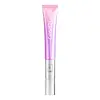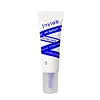What's inside
What's inside
 Key Ingredients
Key Ingredients

 Benefits
Benefits

 Ingredients Side-by-side
Ingredients Side-by-side

Water
Skin ConditioningGlycerin
HumectantDimethicone
EmollientMethylpropanediol
SolventCoco-Caprylate/Caprate
EmollientMaris Aqua
HumectantCyclopentasiloxane
EmollientCetyl Alcohol
EmollientOctyldodecanol
EmollientGlyceryl Stearate
EmollientNiacinamide
SmoothingCyclohexasiloxane
EmollientHydroxyacetophenone
AntioxidantMethyl Hydrogenated Rosinate
PerfumingAmmonium Acryloyldimethyltaurate/Vp Copolymer
PEG-75 Stearate
Tocopheryl Acetate
AntioxidantSteareth-20
CleansingCeteth-20
CleansingButylene Glycol
HumectantBisabolol
MaskingPentylene Glycol
Skin ConditioningLactobacillus/Soymilk Ferment Filtrate
Skin ConditioningGentiana Scabra Root Extract
Skin ConditioningHydroxyphenyl Propamidobenzoic Acid
Skin ConditioningCaffeine
Skin ConditioningSodium Hyaluronate
HumectantPalmitoyl Pentapeptide-4
Skin ConditioningTocopherol
AntioxidantCeramide EOP
Skin ConditioningCeramide AP
Skin ConditioningCeramide Ns
Skin ConditioningCeramide As
Skin ConditioningAcetyl Tetrapeptide-5
HumectantDipeptide Diaminobutyroyl Benzylamide Diacetate
Skin ConditioningChondrus Crispus Extract
Skin ConditioningSmithsonite Extract
AntioxidantPeumus Boldus Leaf Extract
MaskingMoringa Oleifera Seed Extract
Skin ConditioningZea Mays Kernel Extract
Palmaria Palmata Extract
Skin ProtectingPhytosteryl/Octyldodecyl Lauroyl Glutamate
Skin ConditioningCeramide NP
Skin ConditioningEchinacea Purpurea Extract
MoisturisingAscorbyl Palmitate
AntioxidantLycium Barbarum Fruit Extract
AstringentTrehalose
HumectantSophora Flavescens Root Extract
AntioxidantAloe Barbadensis Leaf Extract
EmollientHydrogenated Lecithin
EmulsifyingDendrobium Nobile Stem Extract
Skin ConditioningErythritol
HumectantXanthan Gum
EmulsifyingPentaerythrityl Tetra-Di-T-Butyl Hydroxyhydrocinnamate
AntioxidantDisodium EDTA
Cyclodextrin
AbsorbentPolysorbate 20
EmulsifyingCarbomer
Emulsion StabilisingArginine
MaskingWater, Glycerin, Dimethicone, Methylpropanediol, Coco-Caprylate/Caprate, Maris Aqua, Cyclopentasiloxane, Cetyl Alcohol, Octyldodecanol, Glyceryl Stearate, Niacinamide, Cyclohexasiloxane, Hydroxyacetophenone, Methyl Hydrogenated Rosinate, Ammonium Acryloyldimethyltaurate/Vp Copolymer, PEG-75 Stearate, Tocopheryl Acetate, Steareth-20, Ceteth-20, Butylene Glycol, Bisabolol, Pentylene Glycol, Lactobacillus/Soymilk Ferment Filtrate, Gentiana Scabra Root Extract, Hydroxyphenyl Propamidobenzoic Acid, Caffeine, Sodium Hyaluronate, Palmitoyl Pentapeptide-4, Tocopherol, Ceramide EOP, Ceramide AP, Ceramide Ns, Ceramide As, Acetyl Tetrapeptide-5, Dipeptide Diaminobutyroyl Benzylamide Diacetate, Chondrus Crispus Extract, Smithsonite Extract, Peumus Boldus Leaf Extract, Moringa Oleifera Seed Extract, Zea Mays Kernel Extract, Palmaria Palmata Extract, Phytosteryl/Octyldodecyl Lauroyl Glutamate, Ceramide NP, Echinacea Purpurea Extract, Ascorbyl Palmitate, Lycium Barbarum Fruit Extract, Trehalose, Sophora Flavescens Root Extract, Aloe Barbadensis Leaf Extract, Hydrogenated Lecithin, Dendrobium Nobile Stem Extract, Erythritol, Xanthan Gum, Pentaerythrityl Tetra-Di-T-Butyl Hydroxyhydrocinnamate, Disodium EDTA, Cyclodextrin, Polysorbate 20, Carbomer, Arginine
Water
Skin ConditioningGlycerin
HumectantNiacinamide
SmoothingButylene Glycol
HumectantSqualane
EmollientCetyl Ethylhexanoate
EmollientAluminum Starch Octenylsuccinate
Absorbent1,2-Hexanediol
Skin ConditioningCaffeine
Skin ConditioningPentylene Glycol
Skin ConditioningAcrylates/C10-30 Alkyl Acrylate Crosspolymer
Emulsion StabilisingArginine
MaskingPanthenol
Skin ConditioningHydroxyacetophenone
AntioxidantAmmonium Acryloyldimethyltaurate/Vp Copolymer
PPG-5-Ceteth-10 Phosphate
EmulsifyingHydrogenated Olive Oil Unsaponifiables
EmollientSodium Polyacrylate
AbsorbentSodium Hyaluronate
HumectantAdenosine
Skin ConditioningAllantoin
Skin ConditioningTocopheryl Acetate
AntioxidantCitrus Junos Peel Oil
AstringentGlyceryl Acrylate/Acrylic Acid Copolymer
HumectantDipotassium Glycyrrhizate
HumectantPortulaca Oleracea Extract
Skin ConditioningWater, Glycerin, Niacinamide, Butylene Glycol, Squalane, Cetyl Ethylhexanoate, Aluminum Starch Octenylsuccinate, 1,2-Hexanediol, Caffeine, Pentylene Glycol, Acrylates/C10-30 Alkyl Acrylate Crosspolymer, Arginine, Panthenol, Hydroxyacetophenone, Ammonium Acryloyldimethyltaurate/Vp Copolymer, PPG-5-Ceteth-10 Phosphate, Hydrogenated Olive Oil Unsaponifiables, Sodium Polyacrylate, Sodium Hyaluronate, Adenosine, Allantoin, Tocopheryl Acetate, Citrus Junos Peel Oil, Glyceryl Acrylate/Acrylic Acid Copolymer, Dipotassium Glycyrrhizate, Portulaca Oleracea Extract
Ingredients Explained
These ingredients are found in both products.
Ingredients higher up in an ingredient list are typically present in a larger amount.
Ammonium Acryloyldimethyltaurate/Vp Copolymer (let's call it AAVC for short) is a synthetically created polymer. It's used as a film-forming agent and used to thicken the consistency of products.
AAVC is able to increase the consistency and viscosity of products due to its large molecule size. It also prevents ingredients from separating.
Arginine is an amino acid that is important for human development. Your body uses is it to produce hair keratin and skin collagen.
As a cosmetic ingredient, Arginine has antioxidant properties and can also help repair damaged skin. This ingredient is derived either synthetically or from animals.
Arginine isn't fungal acne safe when used in the presence of other lipids (fats, fatty acids, oils, esters, etc). Oils and fats occur naturally within the skin, so take caution when using Arginine if you're prone to fungal acne.
Learn more about ArginineButylene Glycol (or BG) is used within cosmetic products for a few different reasons:
Overall, Butylene Glycol is a safe and well-rounded ingredient that works well with other ingredients.
Though this ingredient works well with most skin types, some people with sensitive skin may experience a reaction such as allergic rashes, closed comedones, or itchiness.
Learn more about Butylene GlycolCaffeine is most associated with coffee, tea, and cacao. In skincare, it helps with calming inflammation and is rich in antioxidants.
While caffeine is used to treat cellulite and and dark circles, further studies are needed to prove this. It has been believed to help with these skin conditions due to its ability to dilate blood vessels and increase blood flow.
Some studies are looking into caffeine's ability to protect against UV rays.
Learn more about CaffeineGlycerin is already naturally found in your skin. It helps moisturize and protect your skin.
A study from 2016 found glycerin to be more effective as a humectant than AHAs and hyaluronic acid.
As a humectant, it helps the skin stay hydrated by pulling moisture to your skin. The low molecular weight of glycerin allows it to pull moisture into the deeper layers of your skin.
Hydrated skin improves your skin barrier; Your skin barrier helps protect against irritants and bacteria.
Glycerin has also been found to have antimicrobial and antiviral properties. Due to these properties, glycerin is often used in wound and burn treatments.
In cosmetics, glycerin is usually derived from plants such as soybean or palm. However, it can also be sourced from animals, such as tallow or animal fat.
This ingredient is organic, colorless, odorless, and non-toxic.
Glycerin is the name for this ingredient in American English. British English uses Glycerol/Glycerine.
Learn more about GlycerinHydroxyacetophenone is antioxidant with skin conditioning and soothing properties. It also boosts the efficiency of preservatives.
This ingredient is not irritating or sensitizing.
Niacinamide is a multitasking form of vitamin B3 that strengthens the skin barrier, reduces pores and dark spots, regulates oil, and improves signs of aging.
And the best part? It's gentle and well-tolerated by most skin types, including sensitive and reactive skin.
You might have heard of "niacin flush", or the reddening of skin that causes itchiness. Niacinamide has not been found to cause this.
In very rare cases, some individuals may not be able to tolerate niacinamide at all or experience an allergic reaction to it.
If you are experiencing flaking, irritation, and dryness with this ingredient, be sure to double check all your products as this ingredient can be found in all categories of skincare.
When incorporating niacinamide into your routine, look out for concentration amounts. Typically, 5% niacinamide provides benefits such as fading dark spots. However, if you have sensitive skin, it is better to begin with a smaller concentration.
When you apply niacinamide to your skin, your body converts it into nicotinamide adenine dinucleotide (NAD). NAD is an essential coenzyme that is already found in your cells as "fuel" and powers countless biological processes.
In your skin, NAD helps repair cell damage, produce new healthy cells, support collagen production, strengthen the skin barrier, and fight environmental stressors (like UV and pollution).
Our natural NAD levels start to decline with age, leading to slower skin repair, visible aging, and a weaker skin barrier. By providing your skin niacinamide, you're recharging your skin's NAD levels. This leads to stronger, healthier, and younger looking skin.
Another name for vitamin B3 is nicotinamide. This vitamin is water-soluble and our bodies don't store it. We obtain Vitamin B3 from either food or skincare. Meat, fish, wheat, yeast, and leafy greens contain vitamin B3.
The type of niacinamide used in skincare is synthetically created.
Learn more about NiacinamidePentylene glycol is typically used within a product to thicken it. It also adds a smooth, soft, and moisturizing feel to the product. It is naturally found in plants such as sugar beets.
The hydrophilic trait of Pentylene Glycol makes it a humectant. As a humectant, Pentylene Glycol helps draw moisture from the air to your skin. This can help keep your skin hydrated.
This property also makes Pentylene Glycol a great texture enhancer. It can also help thicken or stabilize a product.
Pentylene Glycol also acts as a mild preservative and helps to keep a product microbe-free.
Some people may experience mild eye and skin irritation from Pentylene Glycol. We always recommend speaking with a professional about using this ingredient in your routine.
Pentylene Glycol has a low molecular weight and is part of the 1,2-glycol family.
Learn more about Pentylene GlycolSodium Hyaluronate is hyaluronic acid's salt form. It is commonly derived from the sodium salt of hyaluronic acid.
Like hyaluronic acid, it is great at holding water and acts as a humectant. This makes it a great skin hydrating ingredient.
Sodium Hyaluronate is naturally occurring in our bodies and is mostly found in eye fluid and joints.
These are some other common types of Hyaluronic Acid:
Learn more about Sodium HyaluronateTocopheryl Acetate is AKA Vitamin E. It is an antioxidant and protects your skin from free radicals. Free radicals damage the skin by breaking down collagen.
One study found using Tocopheryl Acetate with Vitamin C decreased the number of sunburned cells.
Tocopheryl Acetate is commonly found in both skincare and dietary supplements.
Learn more about Tocopheryl AcetateWater. It's the most common cosmetic ingredient of all. You'll usually see it at the top of ingredient lists, meaning that it makes up the largest part of the product.
So why is it so popular? Water most often acts as a solvent - this means that it helps dissolve other ingredients into the formulation.
You'll also recognize water as that liquid we all need to stay alive. If you see this, drink a glass of water. Stay hydrated!
Learn more about Water